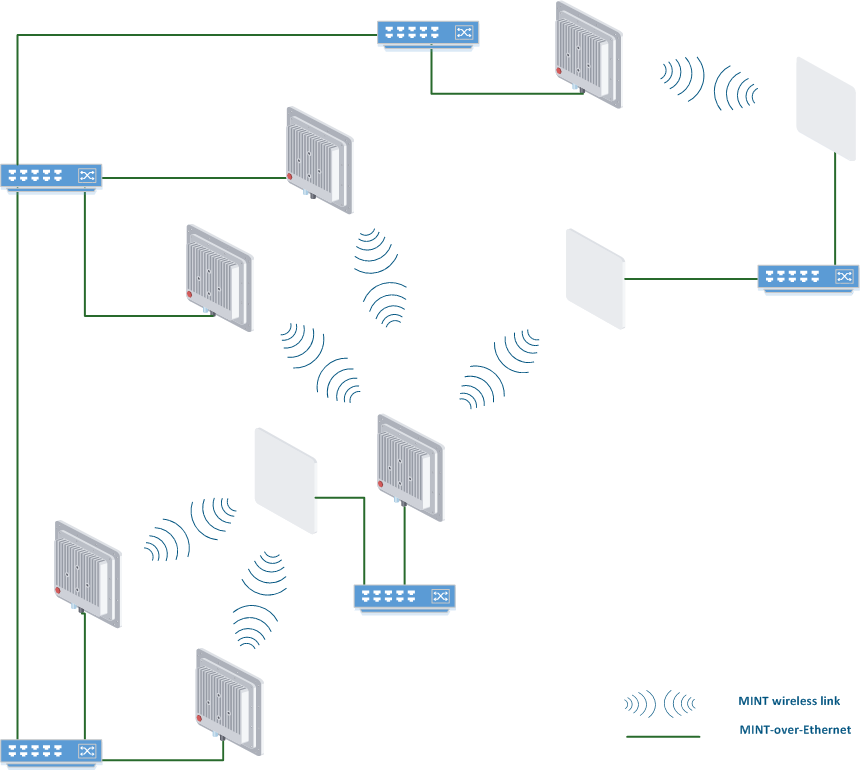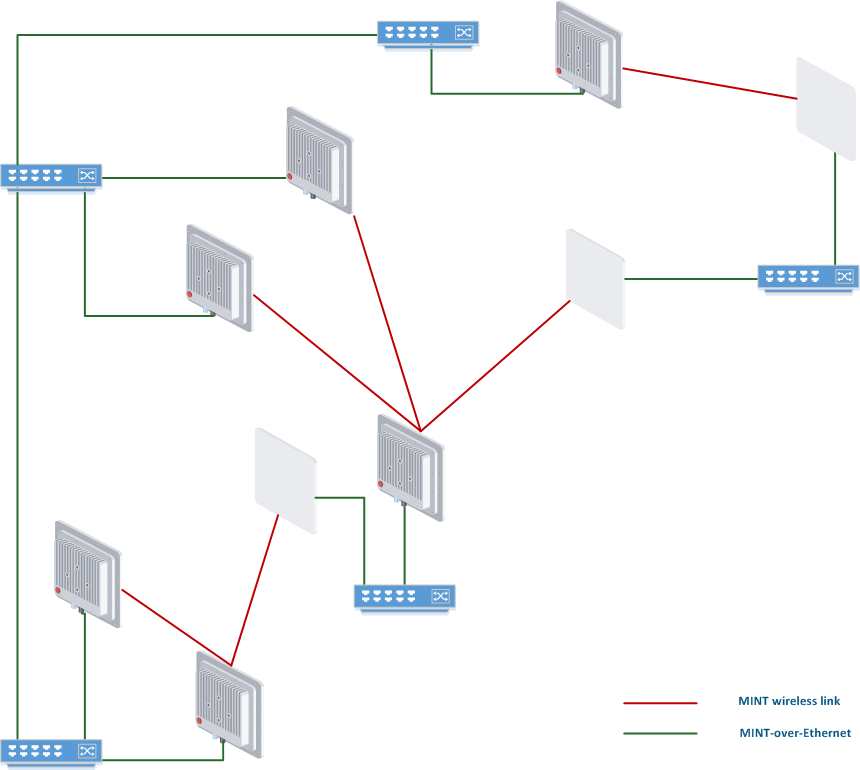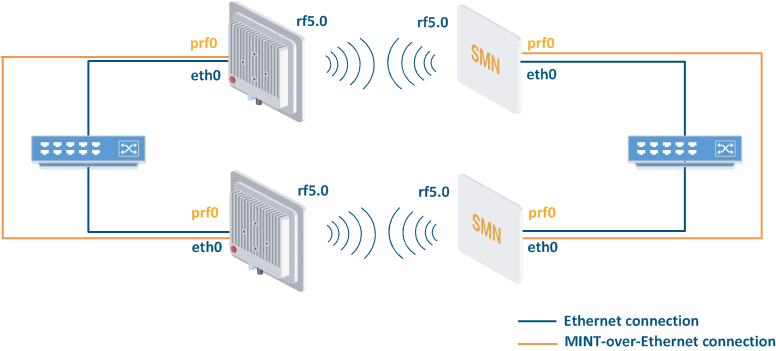| Table of Contents |
|---|
| Hide_comments |
|---|
Abbreviations
The following abbreviations are used in this document:
- IP – Internet Protocol
- MINT - Mesh Interconnection Networking Technology
- PRF – Pseudo Radio interface
- OSPF – Open Shortest Path First
- RCMD – Remote Command
Purpose of this document
InfiNet Wireless is one of the leading manufacturers of Broadband Wireless Access equipment for carrier grade fixed installations. InfiNet Wireless uses its own proprietary transport protocol – MINT which interconnects units by wireless and wired (MINT-over-Ethernet technology provides MINT connectivity over wired Ethernet) links. Within MINT areas, it is possible to send any command via the MINT protocol to a specified unit for execution (MAC address can be used for specific unit selection or broadcast MAC addresses can also be used)
This document shows how units management can be organized using MINT protocol. MINT protocol operates on both Layer 2 and Layer 3. However, in case incorrect or missing IP settings on the units, the management configuration on InfiNet Wireless unit can be restored by issue of MINT RCMD (remote commands) from another InfiNet Wireless unit. MINT management only required L2 and MINT connectivity between units.
Introduction to MINT protocol
MINT – Mesh Interconnection Network Technology
MINT main purpose is to provide path selection with best quality for wireless (and wired) traffic on Layer 2 (switched traffic).
MINT highlights
| Path quality check | MINT constantly checks transmission quality for each link. In case of link degradation MINT quickly changes some parameters in order to keep packet loss value as low as possible automatically. In case of redundant links available, MINT will switch main traffic flow path to link with better transmission quality. |
| Predictive model | MINT supports predictive model to select the best path in advance, in order to deliver data as quickly as possible. |
| Redundancy and load balancing | MINT protocol was designed to work with multiple redundant paths. Moreover, such redundancy can be used for load-balancing to utilize all available connections from one customer point to another. |
| Minimum time for data delivery | MINT main criteria for optimal path selection is time (minimal packet delivery time). |
| MINT connections via wired Ethernet (MINT-over-Ethernet) | MINT-over-Ethernet is unique feature of IW, allows to select best path through network including wired interfaces. Thus, both wireless and wired interfaces would be utilized. MINT-over-Ethernet can be enabled to provide backup and redundant paths, especially for mobile projects. Pseudo Radio Interface (PRF) are virtual interfaces created on base of Ethernet interfaces provides MINT-over-Ethernet. |
| Switching loop prevention | MINT has built-in mechanism to prevent data from looping within MINT network (when redundant paths are present). |
MINT position
MINT link is the link between two units, which use MINT as transport protocol between each other.
...
| Center | ||||||
|---|---|---|---|---|---|---|
|
MINT technology overview
Where MINT is available
Only adjacent neighbor connectivity is needed to create MINT powered link:
- For radio interfaces MINT is enabled by default, only radio parameters should be configured;
- For Ethernet interfaces MINT-over-Ethernet should be enabled manually (disabled by default) for Ethernet interfaces. In case to perform it Pseudo-radio interface (PRF) should be created. Each BS and CPE supports such interfaces.
MINT path selection
In case of multiple MINT routes the protocol would always choose one route for single data frame and would have possibility to re-select new route for another data frame in case of any path characteristics change. Path characteristics are described by aggregated parameter MINT cost.
...
STP BPDU transmission can be blocked in configuration through any logical interfaces.
MINT path selection capabilities
MINT protocol will quickly adjust to possible changes in critical parameters – re-calculate MINT cost for each path and rebuild the path accordingly. Moreover, due to built-in capability to quickly adopt changes, even data flow path within MINT network can change rapidly too.
...
Each decision to change active traffic path can take place every 1-3 seconds depends on MINT protocol settings for every unit.
MINT area
All benefits of MINT protocol mentioned above, would be active only in network there all units supports MINT protocol as the only one transport protocol. Such MINT network is called MINT area. Thus it is required to create unified MINT area consisting of InfiNet Wireless units interconnected by wireless radio interfaces (RF) or by wired MINT-over-Ethernet (Pseudo Radio) interfaces.
| Center |
|---|
Next section contain logical interconnection scheme with RF and PRF links for current physically (wired and wireless) connected units (MINT connections logical scheme).
MINT connections logical scheme
Wireless connection is represented by red link on logical interconnection scheme, wired PRF links are shown in green color.
| Center |
|---|
So, here we have network where almost each unit has at least two connections via MINT protocol. Therefore, it is possible to balance traffic via one or second path (or even load balance using both). In case of one link failure, traffic will flow through the another one. Eventually, under certain circumstances the units can always stay connected because both links down situation is very unlikely to happen. It doesn’t really matter what type of physical connection is used (wired or wireless), MINT use any connection. The only difference is MINT cost value for each link.
MINT RCMD
Within MINT area every MINT node can receive information about another MINT node through its MINT neighbors. Every MINT neighbor exchanges information about its adjacent links, their quality, load, issue and MAC address. MAC address is used as identification label for MINT node.
...
Unique feature of MINT protocol is possibility to send any command to any MINT neighbor for execution at MINT neighbor unit. It is called MINT Remote Command execution (RCMD). MINT RCMD could be helpful in lots of cases, such as: lost password, ip address settings cleared, no possibility to login to remote MINT neighbor directly, it is required to execute some commands on all MINT neighbors.
Examples
Force reboot on remote MINT neighbor
| |||||||
Set new IP address and Default Gateway on remote MINT neighbor
|
| Note | ||
|---|---|---|
| ||
Full syntax of MINT remote commands with different options is described in WANFleX command reference guide Layer 2 commands set -PHY and MAC. |
MINT area prerequisites
In default configuration MINT protocol is enabled and used only between wireless radio interfaces. However, in order to create interconnected MINT area MINT-over-Ethernet interfaces (PRF) are required.
...
Within the same Ethernet broadcast domain (LAN) two (or more) InfiNet Wireless units with PRF interfaces created, can find each other and establish connection via MINT protocol by sending and receiving Ethernet broadcasts frames. Thereafter, InfiNet Wireless units will use Ethernet unicast data transfer.
VLAN considerations
In case two InfiNet Wireless devices are placed within certain VLAN, then configuration of PRF should be performed with certain VLAN tag specified.
MINT-over-Ethernet & VLANs
MINT-over-Ethernet generates broadcast traffic to find other MINT neighbors. Sometimes, such broadcast traffic could be treated as abnormal for network, especially for enterprise networking with comprehensive network security policy.
...
Moreover, in whole MINT-over-Ethernet network different MINT-over-Ethernet areas should be isolated from each other in order to provide complex traffic engineering or prevent undesired traffic path selection. Hence, VLAN separation should be used in such cases.
Configuration part
Steps to configure MINT-over-Ethernet are shown below. Only step 1 is different for untagged approach (1a) and for vlan based approach (1b).
CLI based configuration
1. Create Pseudo Radio (PRF) interface on all devices and set eth0 as parent:
...


